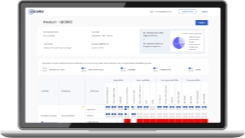
Hiring the right talent is more challenging than ever, with 1 in 4 roles now requiring entirely new skills and 3 out of 4 organizations struggling to find qualified candidates. Now, HR teams are under constant pressure to adapt to changing demands. But here’s the thing what if your recruitment strategy didn’t rely solely on scrambling to fill vacancies?
Enter talent pools: your strategic reserve of skilled candidates, designed to make hiring faster, smarter, and more effective. And when combined with structured onboarding, the results are powerful companies with structured onboarding programs retain 58% of employees for over three years.
By proactively building and nurturing a talent pool, you ease the hiring process and create a foundation for long-term success, agility, and growth.
Ready to unlock the potential of a talent pool? Let’s get started.
What is a Talent Pool and How is it Different from a Talent Pipeline
A talent pool is a dynamic database of individuals who have shown interest in your organization, either by actively applying or by expressing interest in future opportunities. It’s a powerful tool that helps recruiters stay connected with potential candidates, even when there’s no immediate role available.
The talent pipeline, on the other hand, is more specific and immediate. It consists of pre-qualified candidates, both internal and external, who are actively nurtured and prepared to fill critical roles. Unlike a broad talent pool, a pipeline focuses on candidates who are ready to step into a position as soon as the need arises.
Talent Pool vs Talent Pipeline
A talent pool is often confused with a talent pipeline, as the terms are sometimes used interchangeably. However, there is a distinct difference:

Why Do Organizations Need Talent Pools?
Losing a talented candidate simply because there isn’t a role for them right now. That’s a risk recruiters can’t afford to take. The challenges are real: 80% of extra-large, 81% of large, and 78% of medium-sized organizations struggle to fill full-time positions. Rapid technological changes, evolving skill demands, and workforce shortages only add to the pressure.
This is where talent pools come into play. By proactively building a reserve of skilled candidates, organizations can prepare for future hiring needs instead of scrambling to fill roles at the last minute.
Talent pools give businesses the ability to adapt quickly, close skills gaps, and stay aligned with long-term workforce priorities.
How Talent Pools are Strategic Assets in Workforce Development
Talent pools aren’t just a database of resumes they’re your strategic asset to stay competitive. They give organizations the flexibility to hire faster, adapt to changing skill needs, and support leadership priorities with ease.
Instead of reacting to hiring challenges, talent pools empower companies to anticipate them, ensuring they’re always a step ahead.
Let’s dive deeper into how talent pools create real value.
1. Agility in Hiring
Traditional recruitment often takes weeks, if not months, to fill a critical role. This delay impacts productivity and puts added pressure on existing teams. Talent pools address this challenge by maintaining a pre-qualified pipeline of candidates, allowing organizations to act quickly when roles open up.
This highlights the importance of consistent communication and meaningful engagement with candidates. A well-maintained talent pool ensures readiness for future hiring and builds stronger, long-term relationships with potential candidates.
2. A Proactive Response to Skills Gaps
39% of workers’ core skills are expected to change by 2025, reflecting a high and sustained level of disruption despite a slight decline from 44% in 2023 (World Economic Forum). This ongoing shift highlights the critical need for organizations to proactively manage skills gaps and prepare their workforce for the future.
Talent pools provide an effective solution by enabling companies to map competencies, identify emerging skill needs, and develop tailored strategies to meet these demands.
Case Study: Siemens reimagines talent acquisition with Eightfold AI:
A standout example of proactive talent management comes from Siemens, which has adopted a "skills-first" strategy to tackle skill gaps and future workforce needs.
With the help of AI technology like Eightfold, Siemens has implemented an efficient and scalable recruitment process:
- 3 million applications per year are filtered using advanced AI capabilities
- 48,000 job requisitions per year are sourced proactively and time-efficiently
- This strategy enables Siemens to remain competitive and agile in an ever-changing market
The AI-based hiring process involves several steps:
- Decomposing CVs into skills using AI
- Matching skills with all open positions across the organization
- Identifying "strong matches" and "good matches" to streamline candidate selection
- Human intervention to handle contact, dialogue, and final decisions
This approach has allowed Siemens to drastically reduce hiring timelines while maintaining a high-quality talent pipeline. By integrating predictive analytics and AI, Siemens ensures its workforce is always future-ready and capable of addressing industry disruptions.
3. Alignment with Leadership Priorities
Leadership teams are under immense pressure to drive organizational stability, innovation, and efficiency. Talent pools provide a strategic advantage by directly addressing three core leadership priorities:
- Business Continuity: Sudden vacancies can disrupt operations and slow progress. Talent pools enable organizations to respond quickly by having pre-qualified candidates ready to step into critical roles.
- Access to Future-Ready Skills: As industries evolve rapidly, talent pools ensure a consistent pipeline of candidates with the skills needed to drive transformation and innovation.
- Cost Optimization: By reducing time-to-hire and improving employee retention, talent pools help significantly lower recruitment costs while maintaining quality hires.
How to Build a Talent Pool
For organizations in the growth phase, building a talent pool is not just a proactive recruitment strategy it’s a strategic imperative. It signifies a commitment to staying ahead in a competitive market by ensuring the workforce evolves in sync with business demands.

Step 1: Conduct Strategic Workforce Planning Meetings
These meetings provide the framework for developing a talent pool, ensuring the approach is intentional and aligned with business priorities. During these meetings, HR teams and leadership collaboratively address key questions that drive the process forward:
- Which roles are critical for driving business growth?: Identifying roles that directly impact the organization’s success ensures the focus is on the most essential areas.
- What skills will the organization need in the next 3-5 years?: Forecasting skill requirements helps prepare for future market demands and innovation.
- Where are the current gaps, and how can they be filled proactively?: By mapping existing capabilities and identifying shortages, the team creates a clear action plan to close gaps before they hinder progress.
These discussions ensure the talent pool aligns with the organization’s strategic goals and positions the workforce to meet both current and future demands effectively.
To supplement these discussions, HR gathers managers and the L&D team to analyze current skills, gaps, and future requirements. In this stage, the HR team will know if the employees have outdated skills, and what untapped potential can be harnessed with the right opportunities.
To organize this information effectively, HR must list the skills and use a Skill Matrix a tool that helps the team gauge the proficiency of the employees. This step not only clarifies what the company needs but also provides a strategic direction for workforce growth.
Step 2: Assess and Organize Current Workforce Capabilities
With the strategic goals and priorities outlined, HR must evaluate the current workforce to understand the existing skills and gaps. This involves:
- Mapping Current Skills:
- Collaborating with department managers and the L&D team to identify the skills and competencies already present within the organization.
- Using tools like a Skill Matrix to assess proficiency levels and identify strengths.
- Identifying Gaps and Untapped Potential:
- Analyzing where skills are outdated or missing to align with future business needs.
- Recognizing employees with untapped potential who can be developed for future roles through upskilling or reskilling initiatives.
- Segmenting Roles and Skills:
- Creating an organized view of the workforce by categorizing roles based on their criticality to business growth.
- Highlighting high-risk areas where skills are lacking or turnover is likely.
This step not only clarifies what the organization currently has but also highlights the actions needed to close gaps proactively. It ensures the workforce is aligned with the company’s strategic vision and positions internal talent for future opportunities.
Step 3: Expand and Track Talent Sources
At this stage, the HR team focuses on broadening the talent pool by identifying potential candidates who align with the organization’s strategic workforce goals. The objective is to ensure the pool includes a diverse mix of talent that caters to both immediate and long-term needs.
To achieve this, HR teams can:
- Create Comprehensive Job Descriptions: Craft detailed and precise job descriptions that clearly communicate the skills, competencies, and qualifications required for critical roles.
- Encourage Skill-Based Profiles: Motivate candidates to highlight their unique skills, certifications, and aspirations in their profiles, enabling HR to assess their fit more effectively.
- Leverage Technology for Insights: Use advanced tools or platforms to analyze external talent markets, identify gaps, and track potential candidates who align with the organization’s goals.
- Streamline Candidate Management: Centralize candidate data into an organized system that allows easy tracking, updates, and categorization for future roles.
By taking a structured approach to expanding the talent pool, HR teams can ensure they are building a resourceful and dynamic database of skilled professionals who can drive the organization’s success in the years to come.
Step 4: Organize and Segment the Talent Pool
As the talent pool grows, maintaining structure and clarity becomes critical to ensure efficiency and accessibility. HR teams can organize the pool by implementing segmentation strategies that cater to organizational goals and future workforce needs.
Define Segmentation Criteria: Establish clear categories to streamline searches:
- Job-Oriented Segments: Group candidates based on roles, departments, and qualifications.
- Skill-Based Segments: Categorize by expertise, experience level, and career aspirations.
In addition to the above, creating tagging or labeling mechanisms will allow for quick identification of candidates suitable for specific roles or projects. This structured approach ensures HR teams can locate the right candidates when opportunities arise and communicate effectively with tailored messaging for each segment.
Step 5: Building Genuine Connections with Your Talent Pool
A talent pool isn’t just a database of resumes it’s a community of potential teammates. Engaging candidates goes beyond storing profiles; it requires consistent, meaningful interactions. Share updates about your company’s achievements, send tailored job opportunities, and invite candidates to exclusive events like webinars or workshops. These gestures demonstrate that you value their skills and aspirations.
Even small acts, like sending birthday wishes or congratulating them on certifications, can leave a lasting impression. For those who weren’t selected, constructive feedback shows you care about their growth. By nurturing these relationships, you build trust and a sense of belonging, ensuring that when opportunities arise, candidates already feel connected and excited to join your organization.
Step 6: Continuously Refine and Update the Talent Pool
A talent pool is not a static entity it must evolve alongside the organization to remain effective and aligned with changing priorities. HR teams should focus on seamless data integration by using tools like ATS to keep candidate information up-to-date and ensure workflows remain efficient. Predictive insights from data analytics can help anticipate future skill demands, allowing the talent pool to stay proactive and aligned with organizational needs.
Regular audits are essential to maintaining relevance, ensuring outdated profiles are archived, fresh candidates are added, and the pool reflects current business priorities. Additionally, gathering feedback from candidates, employees, and analyzing market trends can help refine engagement strategies and optimize recruitment efforts.
By committing to these continuous improvements, HR teams can transform the talent pool into a dynamic and strategic resource, ensuring it consistently supports the organization's growth and workforce resilience.
The Benefits of a Talent Pool
1. The Hidden Value of Passive Talent Pools
When it comes to hiring, most efforts focus on active job seekers. But what about the 70% of the global workforce who aren’t actively looking but could be persuaded by the right opportunity?
These passive candidates represent a goldmine of expertise and potential, yet they’re often overlooked. In fact, 87% of both active and passive candidates are open to new job opportunities if approached making this group a critical focus for forward-thinking organizations.
Here’s why the passive talent pool matters:
- Access to Rare Skills: Passive candidates often excel in specialized fields like AI, sustainability, and digital transformation skills that are tough to find among active job seekers. By tapping into this group, you gain access to the niche expertise your organization needs to stay ahead.
- High-Quality Hires: These professionals are already thriving in their current roles, meaning they’re proven performers. This makes them more likely to fit your organization and less likely to lead to hiring mistakes, resulting in longer retention rates and better organizational outcomes.
- Future-Ready Workforce: Building a strong passive talent pool means you’re always prepared for critical roles. Instead of scrambling to hire during crunch time, you have a pipeline of pre-qualified candidates ready to step in and keep things moving.
Focusing on passive talent is a competitive advantage that can elevate your hiring efforts and position your organization for long-term success.
2. Reduced Turnover and Associated Costs
Talent pools reduce turnover by pre-qualifying candidates and ensuring they align with the role and company culture before hiring. This proactive approach minimizes mismatched expectations, leading to higher job satisfaction and longer retention.
With a ready pipeline of skilled candidates, organizations cut recruitment costs and rely less on expensive external hiring. By building strong relationships with candidates, talent pools also lower hidden costs, such as lost productivity and rehiring, while creating a stable and engaged workforce.
3. Increased Employee Engagement and Retention
Keeping employees engaged and motivated is a challenge for many organizations, especially when growth opportunities feel limited. Talent pools can help by focusing on internal talent as well as external candidates.
By mapping employee skills and aligning them with future roles, companies can create personalized career plans that show employees a clear path forward. For example, identifying high-potential employees for leadership roles not only ensures stability but also shows a commitment to growth.
4. Enhanced Diversity and Inclusion Initiatives
A strategically built talent pool can drive meaningful progress in diversity and inclusion (D&I). Companies can build a workforce that reflects different perspectives, backgrounds, and ideas by intentionally prioritizing underrepresented groups.
Why D&I Matters:
- Companies with higher gender diversity are 25% more likely to outperform their peers.
- Diverse teams generate 19% more revenue from innovation.
- Over 56% of employees say D&I initiatives improve workplace satisfaction.
5. Access to Future-Ready Skills
Industries are evolving rapidly. The World Economic Forum predicts 44% of workers’ core skills will change within the next 5 years, creating a pressing need for skill-based talent. Talent pools provide access to hidden talent and untapped potential, ensuring companies have pre-qualified candidates ready for emerging roles.
7 Best Practices for Expanding Your Talent Pool
Expanding and maintaining a talent pool database is as essential as building it. Here's how you can optimize and grow your talent pool:
1. Make Talent Pool Browsing a Habit
Expanding your talent pool isn’t just about adding names to a database it’s about keeping it dynamic, relevant, and engaged. Start by making a talent pool browsing a regular habit to ensure you’re always familiar with potential candidates.
2. Keep Former Employees in the Loop
Former employees, often overlooked, can be a hidden goldmine. Reconnecting with those who left on good terms so-called "boomerang employees" can quickly bring skilled professionals back into your fold.
3. Leverage Internal Talent
Don’t forget your internal talent! Including high-performing employees in your talent pool opens opportunities for succession planning and upskilling, especially for hard-to-fill senior roles.
4. Use Personalization to Keep Candidates Engaged
Tailor communication based on where candidates are in their journey:
- Active candidates: Share targeted job openings
- Passive candidates: Provide career resources, industry insights, or skill development content
Use talent pipeline software to segment your talent pool database and send personalized updates, building strong relationships that drive engagement
5. Fill Critical and Hard-to-Hire Positions
- Maintain a segment in your talent pool database for high-priority roles like senior or niche positions
- Keeping internal and external talent pre-qualified ensures these critical roles are filled without delays
- This approach streamlines searches and reduces the time-to-hire for hard-to-recruit positions
6. Maintain and Grow Engagement
Consistent engagement is key share company updates and host virtual webinars, Q&A sessions, or networking events to stay visible and relevant. These consistent touchpoints strengthen relationships and drive talent pool expansion through meaningful engagement
7. Continuously Review and Refresh
Finally, don't let your talent pool database stagnate regularly update candidate profiles, add new talent, and remove inactive candidates. Conduct periodic audits to align your talent pool with current and future organizational needs. Use AI-powered tools to identify gaps or suggest new candidates based on market trends.
Key Takeaway:
Your talent pool database shouldn’t become static it must evolve as a live resource that supports talent pool expansion. By actively browsing, engaging, and leveraging both internal and former employees, you create a dynamic, future-ready talent pool that ensures your hiring needs are met, no matter how challenging the market becomes.
5 Examples of Companies Succeeding with Talent Pools
1. Google
Google’s Careers Platform is all about creating a personalized experience for candidates. By building a profile, you showcase your skills and aspirations while gaining access to tailored job alerts and role recommendations that match your interests. The platform keeps you connected with updates and opportunities, making the application process seamless. It’s not just a job search it’s a chance to stay engaged with Google and be ready when the perfect opportunity comes along!
2. Spotify
Spotify’s Student Programs go beyond traditional internships they’re about building careers. Students don’t need flashy resumes; instead, Spotify values who you are, what you care about, and where you want to go. Interns work on impactful projects alongside passionate teams, directly shaping the company’s future. By creating opportunities for real-world contributions, Spotify nurtures a talent network that prioritizes creativity, passion, and long-term growth, transforming internships into stepping stones for meaningful careers.
3. McKinsey
McKinsey leverages its Alumni Center to maintain a robust talent pool, connecting former employees, current firm members, and corporate recruiters. Alumni use the platform to network, access career opportunities, and enhance their skills, while recruiters post jobs and search for qualified candidates. Features like a searchable directory, event registration, and career resources keep the talent pool engaged. By nurturing professional relationships and providing continuous support, McKinsey ensures its talent pool remains a valuable asset for both alumni and the firm.
4. Mercedes-Benz
Mercedes-Benz’s Talent Network makes connecting with future opportunities effortless. Whether you’re ready to apply or simply want to share your details, the platform keeps you in the loop. Get personalized job alerts that match your interests, stay updated with relevant company news, and easily share opportunities with friends and family via email or social media. It’s all about making your job search simple, engaging, and tailored keeping you connected with Mercedes-Benz every step of the way.
5. PwC
PwC’s Talent Community keeps candidates connected and informed about career opportunities and events. By joining, individuals can select a community that matches their background whether they’re entry-level professionals or experienced experts. This platform allows candidates to share their skills and interests, helping recruiters match them with opportunities that align perfectly. It’s more than a job search; it’s a way to stay engaged with PwC and be ready for the next step in your career journey!
Conclusion
Talent pools are no longer just a "nice-to-have" but a cornerstone of organizational resilience and growth. They have evolved beyond a simple recruitment tool to become the foundation of a forward-looking workforce strategy. With a well-structured talent pool, businesses can ensure long-term success by fostering agility, addressing skills gaps, and staying competitive in a rapidly changing world.
We have seen how proactive talent management and skill-based hiring can transform the way organizations operate in the future. These strategies don’t just fill vacancies they build future-ready teams poised to drive innovation and success.
With Skill Matrix, you can elevate your talent pool strategy by effectively mapping skills, identifying gaps, and aligning your workforce with long-term organizational goals. Ready to redefine your hiring process and future-proof your workforce? Contact Edstellar today and let us help you build a talent pool that positions your organization for lasting success.
Explore High-impact instructor-led training for your teams.
#On-site #Virtual #GroupTraining #Customized

Bridge the Gap Between Learning & Performance
Turn Your Training Programs Into Revenue Drivers.
Schedule a ConsultationEdstellar Training Catalog
Explore 2000+ industry ready instructor-led training programs.

Coaching that Unlocks Potential
Create dynamic leaders and cohesive teams. Learn more now!


Want to evaluate your team’s skill gaps?
Do a quick Skill gap analysis with Edstellar’s Free Skill Matrix tool

Transform Your L&D Strategy Today
Unlock premium resources, tools, and frameworks designed for HR and learning professionals. Our L&D Hub gives you everything needed to elevate your organization's training approach.
Access L&D Hub Resources.svg)
.svg)



.svg)
.webp)

.svg)
.svg)
.svg)
.svg)

